
For those of you with diseases such as chronic obstructive pulmonary disease, emphysema or chronic bronchitis, supplemental medical oxygen is a necessity. If you have ever tried to travel with supplemental oxygen, you know how difficult this can be. Being prepared, and knowing how to travel safely with oxygen and where to obtain oxygen at your final destination is vital. This is where OxygenWorldwide can help with 20 years of expertise the team are ready and waiting. On call 24 hours a day book your next trip no matter how short or long haul and you will always be in safe hands.
Safety is a very important issue when traveling by car, as an oxygen tank can become a dangerous projectile in an accident. It is crucial to secure the unit. Your oxygen company can provide you with information about safe ways to store and protect your particular oxygen unit in a vehicle. In case of break down OxygenWorldwide provide a FREE registration to a Back Up Service – complete details online now and await a confirmation from our team.
Portable oxygen concentrators — which form oxygen by extracting and separating it from the surrounding air, and deliver it through a nasal cannula — may be stored in any position, but they should be padded to protect them from impact.
Travel by airplane also takes a good amount of research and preparation. No airline will allow you to bring aboard your own oxygen cylinder, but many airlines have medical oxygen cylinders available for a fee for use on their planes, such as Alaska Airlines, British Airways, Continental, Delta and Japan Airlines. The oxygen containers used on airplanes vary from airline to airline.
You will also need to contact your airline to learn their requirements for advance notification of your need for medical oxygen. Many airlines will need a letter from your physician in advance of the flight, so they can contact him or her to verify liter flow. The letter should have a date of no more than one year prior to the flight (some airlines require a letter dated no more than 10 days prior to the flight), stating the amount of oxygen needed and the flow rate, adjusted to cabin pressure.
In Europe, the rules and regulations for oxygen use on vary from country to country. There is no one place to find the information for a trip that takes you from country to country. Your best bet is to contact OxygenWorldwide’s customer service department who have a wide range of knowledge in these countries.
Being well prepared will make your travels much more enjoyable.




